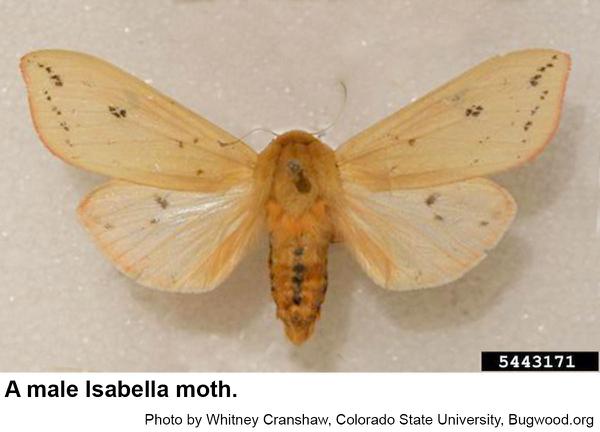Description and Biology
The banded woollybear, Pyrrharctia isabella, is famous for predicting the harshness of the coming winter weather (the wider the black bands, the harsher the winter). It is informally known as the woolly bear, woolly worm, weatherworm, black-ended Bear, and fuzzy wuzzy. The banded woollyworm is also the main feature of a Woollybear Festival each fall in Vermilion, Ohio and a Woolly Worm Festival in Banner Elk, North Carolina. (And it may be the only insect with its own web site: http://www.woollyworm.com/) Mature caterpillars are a little over an inch long and are covered with stiff hairs. Middle segments of the abdomen are covered with rusty red hairs and with black hairs at either end. As the caterpillars grow, black hairs are replaced with orange hairs so that the rusty red band is widest in mature banded woollybears. In fall, these caterpillars seek overwintering shelter under bark, leaf litter or a log, and can survive temperatures as low as -90 F. They overwinter either as caterpillars or they spin flimsy cocoons inside of which they overwinter as pupae. In the spring, the overwintering caterpillars warm back up and begin to feed. They spin cocoons and pupate. Some days later the next generation of Isabella moths emerges to mate and lay eggs on weeds, trees and grasses. Male Isabella moths are buff with small black spots. Female Isabella moths have lovely pink hind wings. There are one or two generations per year in North Carolina.
Host Plants
Banded woollybears feed on plantain (a common weed in many yards) as well as other non-crop plants such as dandelion, dock, aster, goldenrod, and some grasses.
Residential Recommendations
Banded woollybears are quite active and are a barrel of fun to rear. Keep a lid on the box! They need a supply of fresh plantain leaves each day (probably twice a day as the caterpillars grow to their full length). Banded woollybears collected early in the growing season should produce a generation of Isabella moths sometime during the summer. Banded woollybears collected in fall will not produce moths until the following spring. These caterpillars probably have some chilling requirement in order to resume proper development next spring. To rear them into Isabella moths, leave them outside perhaps in a screened cage to keep rodents from eating them. Because banded woollybears are virtually harmless to people, are important in folklore, feed on weeds, and are noticed primarily in autumn after they have finished feeding and are seeking an overwintering shelter, it would not make sense to apply an insecticide for their control.
References
- Butterflies and Moths (A Golden Guide from St. Martin's Press). Mitchell, R. T., H. S. Zim. St. Martin's Press. 160 pp.
- Caterpillars in Your Yard and Garden, Banded Woollybear. Anonymous. No Date. University of Missouri Extension.
- Posts Tagged ‘woolly bear life cycle,’ Fuzzy Wuzzy. Anonymous. 2009? Willow House Chronicles, Rural life in eastern Ontario.
- Species Pyrrharctia isabella - Isabella Tiger Moth - Hodges#8129. Bartlett, T., H. et al. 2020 (revised). BugGuide. Iowa State University Department of Entomology.
- Woolly Worm Festival, 45th Annual, 2022.Festival. Anonymous. 2021. Kiwanis Club of Banner Elk and the Avery County Chamber of Commerce.
- Extension Plant Pathology Publications and Factsheets
- Horticultural Science Publications
For assistance with a specific problem, contact your local N.C. Cooperative Extension Center
This Factsheet has not been peer reviewed.
Publication date: Jan. 30, 2017
Reviewed/Revised: Oct. 9, 2019
N.C. Cooperative Extension prohibits discrimination and harassment regardless of age, color, disability, family and marital status, gender identity, national origin, political beliefs, race, religion, sex (including pregnancy), sexual orientation and veteran status.



